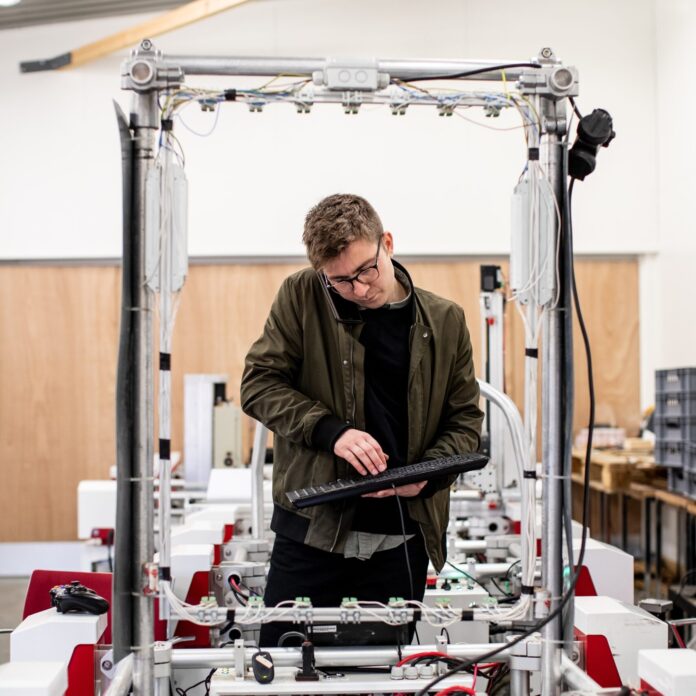“Millions of workers need to be trained for those new roles, and local governments have a really strong role to play in making sure that their communities and their residents and workers are ready for this new challenge.”
We know by now: the pandemic changed daily work for people across the globe. Flex schedules, work-from-home adjustments, Zoom, and other factors became not only the nature of employment for so many, but also, frequently enough, a new foundation for what to expect on the job.
This can start casual conversations about the future of work, where we’re headed; and, indeed, the pandemic brought calibrating factors. But considering others in play—automation, modern robotics, artificial intelligence, and more—the future of work is a big field of study with outcomes that observers believe can be defined by municipal leaders.
“As conveners, employers, and policymakers, city leaders can take entrepreneurial steps to successfully navigate the changing nature of work and build inclusive cities of opportunity and community for years to come,” says the National League of Cities.
The organization’s Center for City Solutions recently released its latest, periodic “America Works” report about the future of work and describes in it five, specific drivers expected to shape the next 10 years. Verbatim from the report:
- The robots are coming, but workers are not.
- Flexibility of work will usher in the era of villages, in cities big and small.
- The urban housing crisis will continue as demand exceeds supply.
- Workers will demand the American Dream.
- Climate Change will be the defining challenge and opportunity for cities.
▐ Robots/Workers
Evolving technology will indeed destroy jobs people are doing now, but will create a greater number of new jobs. In the mix, watchers are seeing automation driven as U.S. population growth slows (reduced immigration and a lower birthrate).
“Really what we’re experiencing right now is not so much a job shortage but a labor shortage, and that’s why we’re seeing this increase in move toward automation and robotics to do some parts of the jobs that humans used to do,” explained Lena Geraghty, Director of Sustainability and Innovation at the Center for City Solutions, in a recent interview with NCLM.
But millions of new jobs are coming about with the rise of automation, she added. “Millions of workers need to be trained for those new roles, and local governments have a really strong role to play in making sure that their communities and their residents and workers are ready for this new challenge,” said Geraghty.
The report also points out that automation will affect workers unevenly. “Workers who complement new automation and perform tasks beyond the abilities of machines will benefit, while workers performing tasks that are substituted by machines will be left out,” it says. “Black Americans and rural workers are more likely to work in jobs that will be displaced by automation and are less likely to live in areas that will benefit from new opportunities.” NLC says the workforce will need the skills and training to match opportunities so inequalities locally and regionally aren’t worsened.
▐ ‘Era of Villages’ Coming
“To us, a village means something that is a smaller part of the community but still has access (to various amenities),” Geraghty said. These villages may grow as flexibility continues to describe the nature of work.
“While the pandemic catalyzed a national transition to remote work, this shift was already a decade in the making,” the report notes. It adds: “Patterns of urbanization today are shaped by a reimagining of where and how work is done, a decentralizing economy, and increasingly digital and flexible work.”
What might this mean to local governments? Experts expect changes ahead for the built environment: “Flexible work means workers will spend more time and a greater share of their income in the neighborhood where they live, increasing demand for new and existing neighborhood retail, restaurants, coffee shops, coworking spaces, and childcare centers.”
At the same time, it could also make for displacement and “siloed neighborhoods of high opportunity and low opportunity.” The report suggests investments in protections against displacement as well as for transit and housing to ensure inclusivity.
“The era of villages in cities big and small has arrived,” says the report.
▐ Housing Crisis
League of Municipalities members already know that the availability of affordable housing is no longer an issue only facing larger cities; in fact, an advocacy goal that North Carolina cities and towns set for the 2021–22 biennium focused on this. A growing number of smaller cities and towns have recognized a lack of affordable housing as major problem facing residents and as an impediment to workforce recruitment.
NLC notes that municipal leaders around the country are reforming zoning codes for density and housing variety. Housing construction rates for single-family and multifamily housing are at their highest since the early 1970s, but supply is mostly favoring the market’s higher end.
“Workers, employers and cities themselves are hurt by high housing costs, as labor shortages are partially spurred by a lack of proximate affordable housing,” NLC’s report says. It adds that increased demand for housing in already popular neighborhoods “can lead to displacement and further social racial inequality” without intervention.
“This might get worse before it gets better,” said Geraghty.
▐ American Dream
Social infrastructure to support families into the future is increasingly in demand, Geraghty said, and local governments may be able to pilot helpful programs. Indeed, NLC in its report says, “Cities are leading the way in creating or convening innovative solutions for a more resilient workforce.” Childcare and housing costs have surpassed unsustainable levels for many community members, for instance. “Entrepreneurial city leaders will begin to build new social infrastructure in this decade to meet the challenge of growing inequality and support the needs of workers,” NLC reports.
▐ Climate Change
“This is one of the big ones,” Geraghty said, noting the next 10 years are critical for action. Municipal transportation and buildings have contributed to the climate crisis, for one. But the growing movement to “decarbonize” our cities is projected to create 25 million new jobs around the country, meaning the crisis pivoting is coming with opportunity.
“City leaders really need to lead the transformation into a sustainable economy,” Geraghty said.
One example of such leadership is the Town of Boone, which early this year appeared to be the first municipality in North Carolina to have shifted from fossil fuels to 100 percent renewable energy for its municipal facilities. It gained the town government national attention. NCLM covered the story on its podcast, Municipal Equation (Episode 67), which also examined the recent NLC report on the future of work (Episode 74).
Tune in at www.municipalequation.libsyn.com for more perspective on how cities are adapting to such changes.
“City leaders are really in the seat to be change agents, both today and moving forward,” said Geraghty, whose reporting notes that the next 10 years in this context may shape the next 100.
The full report, with additional context and recommendations, is available at www.nlc.org/america-works.














